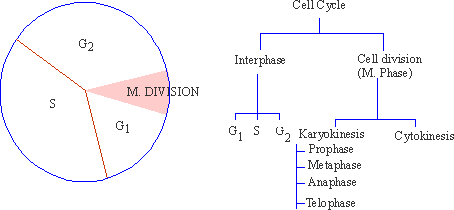|
PinkMonkey Online Study Guide-Biology
6.1 The Cell Cycle
 Click here to enlarge
Click here to enlarge
Figure 6.1 The Cell Cycle
Definition : The cell cycle, also called generation time, is the sequence of events in the life of a cell. The cell cycle starts immediately after one cell division and ends with the completion of the next division.
The cell cycle of eukaryotic cells is classified into
(1) interphase (2) karyokinesis and (3) cytokinesis (Howard and Pelc,
1953).
(1) Interphase : It is the preparatory phase during which the cell is metabolically very active and prepares itself for the division.
Three important processes occur in interphase, viz. (a)
replication of chromosomal DNA, synthesis of RNA and the basic nuclear
proteins (histones) (b) synthesis of energy rich compounds which provide
energy for mitosis and (c) in animal cells, division of the centriole.
On the basis of DNA synthesis, interphase is subdivided into
following three stages.
G1 (Gap1) : It starts immediately after the previous division. Therefore G1 is called gap phase or first growth phase. Synthesis of proteins and RNA takes place. The cell grows in volume.
S phase (Synthesis phase) : It is the period during which DNA synthesis occurs, i.e. replication of chromosomal DNA takes place. This results in doubling of the chromosomal threads.
G2 (Gap 2) : It is the last part of interphase and occurs just before the new cell division. Hence G2 is called pre-division gap phase or second growth phase. It begins after completion of DNA synthesis in the S phase and ends when new division (karyokinesis) commences. During G2, synthesis of proteins and RNA takes place and the nuclear volume increases.
(2) Karyokinesis : It is the division of the parent nucleus into daughter nuclei.
(3) Cytokinesis : This is the division of the cytoplasm. It occurs after karyokinesis and divides the parent cell into daughter cells.
Karyokinesis and cytokinesis together form the M phase (i.e. cell division).
The total duration of a cell cycle varies greatly in different organisms and under different conditions, e.g. it may be as short as 20-30 minutes in the bacterium Escherichia coli or may take 12-24 hours as in most higher plants and animals.
The time required for completion of each phase in the cell cycle varies greatly. In general, actual cell division (M-phase) occupies only a short span of the total cycle while the major span is occupied by the interphase. Normally, time duration of S and G2 phases is more or less equal. The duration of G1 is longer in cells which do not divide frequently, and is very short in cells which divide repeatedly in close succession.
G0 stage : It is a stage during which cell cycle is arrested for an indefinite period.
Significance of cell cycle
-
In multicellular organism, the 'cycling type' of cells (dividing cells) help in reproduction, growth and replacement of dead cells, healing of wounds, etc.
The interphase allows time for synthesis and growth of the dividing cell. Properly controlled and regulated cell cycle results in normal and proportionate growth of organisms. Loss of control over the cell cycle can lead to cancerous growth.
Cancerous cells : For some reason, in some cells, if the control over the cell cycle is lost, then they start behaving abnormally. These cells divide repeatedly in an uncontrolled manner at abnormally high rates. As a result, they do not get enough time for growth and differentiation. Such cells mass together and form tumors in the body which may lead to cancer.
The cancerous or malignant cells are those which show continuous and uncontrolled growth through repeated cell divisions at abnormally high rates.
In the cancerous tissue, the metabolism of cells is disturbed
and abnormal. The cells continue to move and crawl (grow) over one another,
i.e., they do not show contact inhibition. The cancerous growth may remain
localized or may spread to other parts of the body.
|